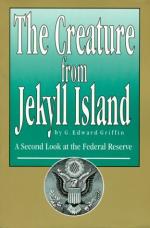
|
| Name: _________________________ | Period: ___________________ |
This quiz consists of 5 multiple choice and 5 short answer questions through Section IV. A Tale of Three Banks, Chapters 16-19 The Creature Comes to America; A Den of Vipers; Loaves and Fishes, and Civil War; Greenbacks and Other Crimes.
Multiple Choice Questions
1. What other organizations were spawned from Milner's secret society?
(a) Other parts of the secret society showed up as the Noble Prize Commission.
(b) Other parts of the secret society showed up as the International Money Fund.
(c) Other parts of the secret society showed up as the Council on Foreign Relations and even the Red Cross.
(d) Other parts of the secret society showed up as the World Bank and Red Cross.
2. What type of person was Paul Moritz Warburg?
(a) Paul Moritz Warburg was a stubborn man concerned only with the wealth of the upper class.
(b) Paul Moritz Warburg was an elitist who was not concerned with the concerns of the poor.
(c) Paul Moritz Warburg was a mild-mannered, shy and sensitive man.
(d) Paul Moritz Warburg was a rude and greedy man.
3. How did England and France, at least in part, finance their wars?
(a) England and France went heavily into war debt until they hired political financial excerpts from the Far East.
(b) England and France went heavily into debt until the countries had to hire the House of Morgan in partnership with the Rothschilds to sell their war bonds.
(c) England and France went heavily into war debt causing them to reduce the sizes of their armies.
(d) England and France went heavily into debt until the countries sold their war bonds to the US.
4. How does a currency drain occur within the banking system?
(a) A currency drain occurs when the Federal government demands repayment of loans.
(b) A currency drain occurs when the government devalues the currency system.
(c) A currency drain occurs when foreign investors withdrawn their funds from US banks.
(d) A currency drain happened when many depositors wrote checks, and the receivers of the checks cashed them at another bank, thereby requiring more money from the first bank than it had on hand.
5. Prior to the establishment of the Federal Reserves, what caused massive bank failures?
(a) US bonds were devalued by the Federal authorities.
(b) There were public runs on the banks and currency drains from other banks demanding payments.
(c) The Great Depression proved to be an unbearable strain on the banking system.
(d) Foreign debtors demanded the full repayment of loands.
Short Answer Questions
1. Some tactics include cherry-picking examples while oversimplifying causes.
2. How did the banks make their money?
3. What did the author argue resulted from the establishment of the IMF and World Bank and the abandonment of the gold standard?
4. Which European bank become the model for the Federal Reserve System?
5. During the history of the world, what types of things were first traded?
|
This section contains 692 words (approx. 3 pages at 300 words per page) |

|




